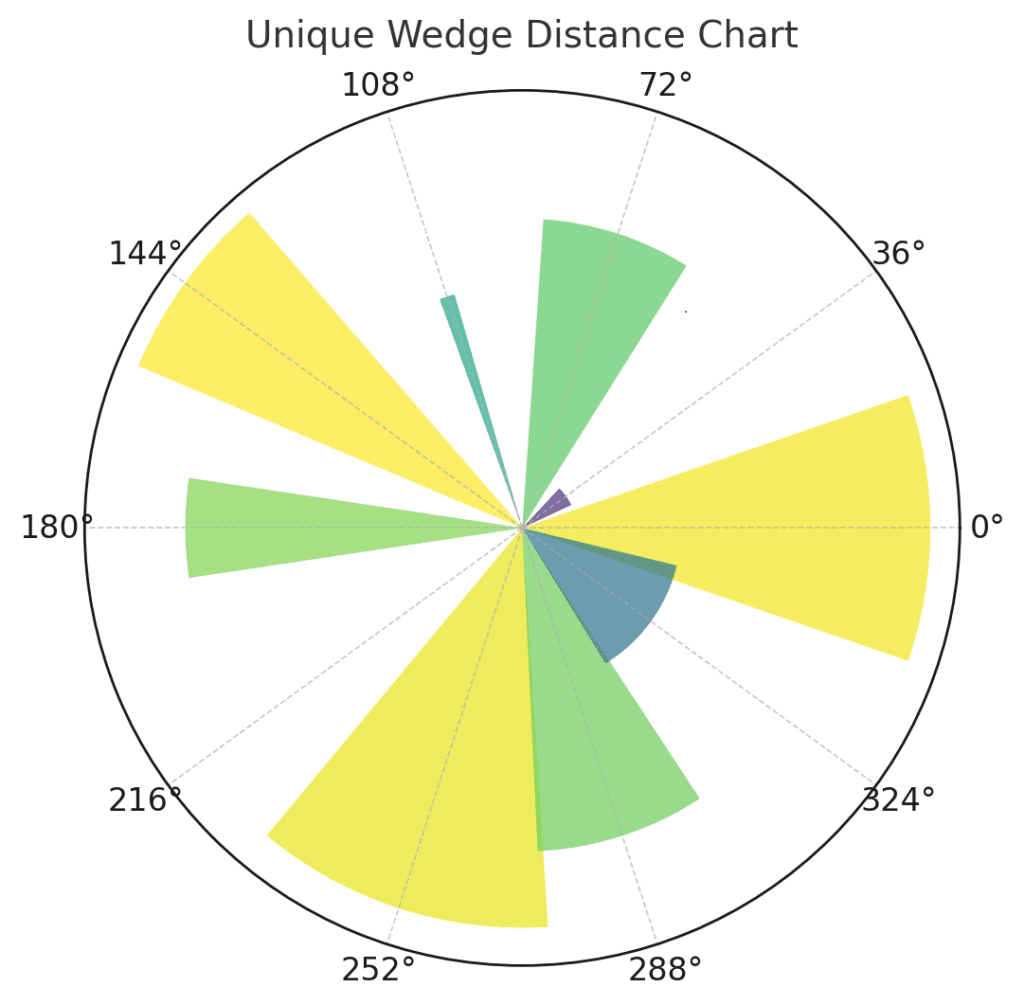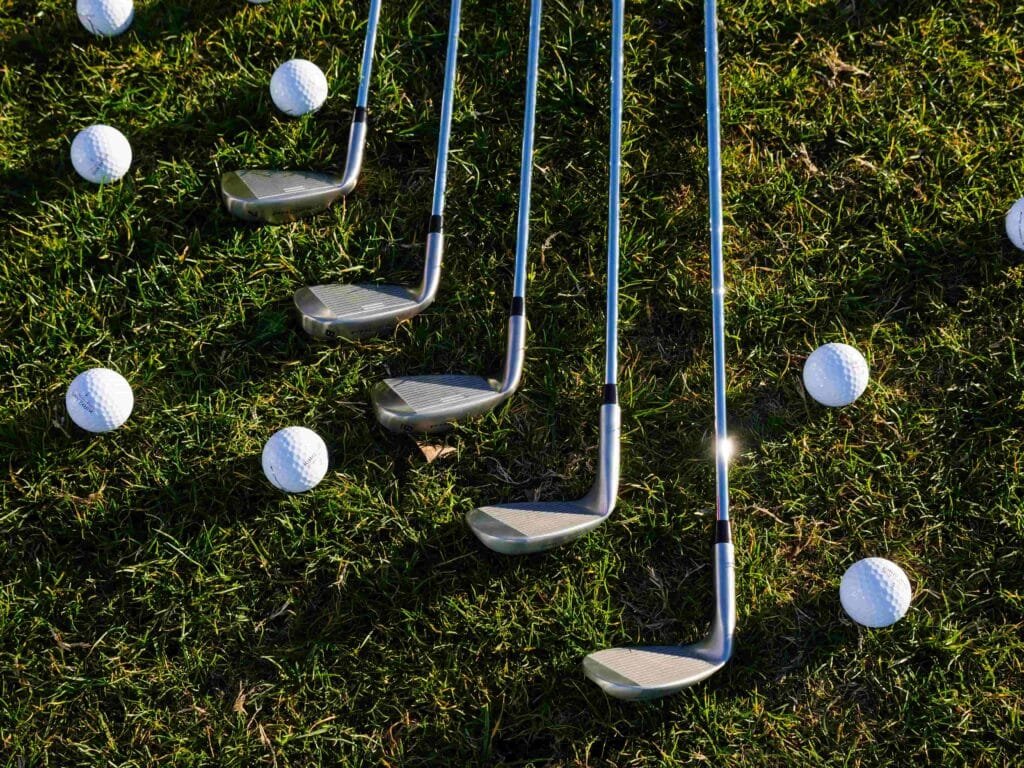
How Far Should You Hit Your Wedges? A Complete Distance Guide
How to Measure How Far You Hit Your Wedges:
To calculate the distance you hit your wedges, first go to the driving range and track the distance to your target using a rangefinder or GPS.
You must hit multiple shots with every wedge, tracking your average carry distance (getting at least 10 shots per club for accuracy).
If you have access to a launch monitor, it will provide you with more accurate numbers on ball speed, spin, and carry distance.
We would certainly recommend testing and recording your yardages in some conditions, noting that factors such as swing speed, type of ball, and course conditions can all impact your wedge distances.
To get a full picture of your wedge distances, try hitting multiple wedges of each loft from a target distance (like 75 or 100 yards).
Table of Contents
Distance management and short-game strategy:
To choose the correct wedge for your golf, the distance guide for popular wedges can help in improving performance.
Each wedge type like pitching, gap, sand, or lob has a specific distance range based on skill level and swing speed.
For example, a pitching wedge usually has a range of 110-140 yards, and a gap wedge covers the gap at about 90-110 yards.
Sand wedges are typically used for shorter shots of about 70-90 yards, while lob wedges are best for shots of under 70 yards.
Knowing these broad principles gives players an informed understanding of how to adjust their short game for ultimate efficiency.

Wedge Distance Table & Chart:
| Wedge Number | Angle | Distance | Width (Radians) |
|---|---|---|---|
| 1 | 0.00 | 2.00 | 0.52 |
| 2 | 0.79 | 3.14 | 0.52 |
| 3 | 1.57 | 4.29 | 0.52 |
| 4 | 2.36 | 5.43 | 0.52 |
| 5 | 3.14 | 6.57 | 0.52 |
| 6 | 3.93 | 7.71 | 0.52 |
| 7 | 4.17 | 8.86 | 0.52 |
| 8 | 5.50 | 10.00 | 0.52 |

56-Degree Wedge Distance – How Far Should You Hit a 56-Degree?
For golfers looking to perfect shots like bunker escapes or short approaches, it’s important to practice in various conditions. Many golf courses in Scotland offer varied challenges to help you master these shots.
A sand wedge (also known as a 56-degree wedge) is used for more versatile short-game situations but is great for bunker shots, chip shots as well as approach shots.
Average Distance:
Golfers can typically hit a 56-degree wedge 75 to 100 yards, depending on their skill level, swing speed and conditions.
Amateurs:
The average amateur golfer hits at a distance of anywhere between 70 to 90 yards.
Pros:
With professionally refined mechanics and higher swing speeds, professionals may be nearer 100–110 yards.
Factors Affecting Distance:
Swing speed:
The faster the swing, the longer the ball flies.
Loft and Spin:
A higher loft generates more spin and therefore controls distance better.
Shot Type:
A longer full swing goes further; a shorter or finesse shot, less distance.
Use Cases: .
When you need to hit an approach shot to the green, get out of a bunker, or land a shot with spin and stopping power.
50 vs 52 Degree Wedge – Which Gap Wedge is Best?
A 50-degree wedge or 52-degree wedge is typically a personal preference based on your wedge configuration, a distance gap in your bag and personal preference.
Purpose of a Gap Wedge:
The gap wedge fills the yardage gap between the pitching wedge (typically 45-48 degrees) and the sand wedge (generally 54-56 degrees).
Distance Differences:
50-Degree: Offers a bit more distance (roughly 90–110 yards for amateurs, 105–125 yards for pros).
52-Degree:
A club that offers extra loft and spin, the best use case for this club is in controlled approach shots (roughly 80–100 yards for amateurs, 95–115 yards for pros).
When to Choose Each:
50-Degree:
Select this if your pitching wedge loft is on the stronger side (in the 44–46 degree range) and you need a tighter gap.
52-Degree:
Choose this option if you like more loft for stopping power and your pitching wedge loft is around 47– 48 degrees.
60-Degree Wedge Distance – How Far Should a 60-Degree Wedge Go?
The 60-degree wedge, also known as a lob wedge, is built for precision and high-loft shots. It is excellent for greenside finesse, bunker shots, and clearing obstacles.
Average Distance:
Amateurs:
Typically 50–75 yards.
Pros:
With an optimised technique, they can reach 80–100 yards, though it’s more commonly used for shorter shots.
Key Factors:
Loft:
Its high loft makes it unsuitable for long distances but excellent for soft landings.
Swing Type:
Full swings are rare with a 60-degree wedge, as it’s primarily used for delicate short-game scenarios.
Spin:
Generates significant backspin, helping stop the ball quickly on the green.
Usage:
Best suited for high-flop shots, short chips, and getting out of deep bunkers or rough. It’s not ideal for full-swing distance shots unless you have exceptional control.
Understanding Wedge Degrees: Loft and Purpose Explained
All golf wedge degrees are for golfers who want to improve their short game. Wedges are speciality clubs that are meant to be used for specific shots, often for shorter distances or challenging situations.
Loft, the angle of the clubface, is a crucial factor in how high and far the ball can go. For example, a pitching wedge has a loft of around 44° to 48° and is used for longer approach shots.
While a sand wedge, which has a loft of around 54° to 58°, is designed for getting out of bunkers or soft lies.
Higher-lofted wedges—including the lob wedge, 58° and 60° or more—could also hit delicate, high-arcing shots designed for tight quarters near the green.
Golfers can dial in their performance on the golf course by optimising for control, spin, and accuracy, which is all possible by selecting the right wedge degree.
What degree is a gap/approach wedge?
A gap or approach wedge is normally between 50 and 54 degrees of loft. This club fills a crucial gap in your bag, covering the distance between your pitching wedge (typically 45 to 48 degrees) and your sand wedge (typically 54 to 58 degrees).
The exact degree can differ according to the manufacturer’s design, so if you’re unsure, you can check your club specifications.
The ability to utilise a gap wedge correctly aids you in control of ranges that could be too brief for your pitching wedge and too big for the sand wedge.
What Degree is a Pitching Wedge?
A pitching wedge degree generally ranges between 44° and 48°.
Fairways hybrids have followed the same trend, with lower lofts becoming increasingly common in both categories.
By making this adjustment, players can gain more yardage while still being in control.
| Brand | Iron Model | Pitching Wedge Degree | Type |
| Taylor Made | Stealth | 43° | Distance/Player Improvement |
| P790 | 45° | Player’s Distance Iron | |
| P7MC | 46° | Player’s Iron | |
| Callaway | Paradym | 43° | Distance/Player Improvement |
| Apex Pro | 45° | Player’s Iron | |
| Rogue ST Max | 41.5° | Super Game Improvement | |
| Titleist | T100 | 46° | Player’s Iron |
| T200 | 44° | Player’s Distance Iron | |
| T300 | 43° | Game Improvement Iron | |
| Ping | G430 | 41° | Game Improvement Iron |
| i230 | 46° | Player’s Iron | |
| G710 | 44.5° | Super Game Improvment | |
| Mizunu | JPX923 Hot Metal | 42.5° | Distance/Game Improvement |
| MP-225 | 46° | Player’s Iron | |
| JPX923 Forged | 45° | Player’s Distance Iron | |
| Cobra | Aerojet | 41° | Game Improvement Iron |
| King Forged Tec | 44° | Player’s Distance Iron | |
| T-Rail | 42.5° | Super Game Improvement | |
| Cleveland | LAUNCHER XL | 44° | Game Improvement Iron |
| RTX ZIP CORE | 46° | Wedge/Player’s Iron | |
| Wilson | D9 FORGED | 44.5° | Player’s Distance Iron |
| STAFF MODEL CB | 46° | Player’s Iron | |
| PXG | 0311 GEN6 T | 46° | Player’s Iron |
| 0311 GEN6 XP | 44° | Game Improvement Iron | |
| 0211 XCOR2 | 44.5° | Game Improvement Iron | |
| Bridgestone | Tour B JGR HF2 | 44° | Game Improvement Plan |
Why Should You Carry Multiple Wedges?

This common advice is vital to remember if you are a golfer looking to sharpen up your short game and course play.
Each wedge is engineered for a certain loft and function, which enables players to navigate all types of scenarios with accuracy.
A pitching wedge, for example, is used for longer approach shots, while a sand wedge is recommended when in a bunker or a softer lie. On the other hand, a lob wedge has the loft for as high a shot as you want with a soft landing near the pin.
By having multiple wedges in your bag, you can adjust to different course conditions, better control your shot distances, and approach tough lies with confidence.
Ultimately, this versatility means lower scores and a more true-and-just game.
Which Wedges Should I Carry?
Wedge selection can make or break a golfer’s game. Most players have at least a pitching wedge, gap wedge, sand wedge, and lob wedge, which are ideal for adjusting to different distances and situations.
Your choice of wedges can make or break your game. While your playing style and the courses you play can alter the answer, there is a general recommendation for a typical golfer:
Pitching Wedge (PW):
Between 45 – 48 degrees Great for full swings from approximately 120 yards or less.
Gap Wedge (GW):
Typically 50 to 54 degrees as previously mentioned. Best for mid-range approach shots requiring a bit of extra air.
Sand Wedge (SW):
Ranges from 54 to 58 degrees, designed for sand play and shorter approach shots.
Lob Wedge (LW):
Usually lofted between 58 and 64 degrees, most useful for precise shots that need a high trajectory, such as reaching over obstacles.
Depending on the types of wedges you choose whether speciality or not this versatility will help in providing greater control over your shots in both fringe and difficult situations.
How to Hit Partial Shots Under 75 Yards
Before you can hit a good partial shot, you need to be able to control your swing length and ball flight. To do so, pull back your swing — imagine creating a “clockface” in your mind’s eye.
A backswing stopping at 9 o’clock, for instance, can produce a lower, controlled shot that’s a great choice from these distances.
Stance and ball position are also critical, moving the ball back a little in your stance to create a more descending blow while maintaining an identical rhythm and tempo over the entire shot.
Regular practice on these components develops the familiarity necessary to execute with confidence in a round.
How to Hit the In-Between Wedge Shots?
Possibly the most difficult shots that a golfer will face are the in-between yardages, where a full swing may send the golf ball too far and a half-swing seems a lightweight option.
One of the more difficult types of shots to hit, wedge shots require precision and feel. Here’s how you might execute such shots effectively:
- Assess the Distance
Measure the distance to the hole precisely. This means knowing the distance at which you normally hit each one of your wedges.
- Choose the Right Wedge
Gap, sand, or lob wedge: Use judgment here — depending on the distance and flight of shot desired.
- Adjust Stance and Grip
Stance: Open your stance a little and play the ball centre or a little forward of centre if you are confident.
Set the Right Grip Pressure: This is a tricky one!
- Focus on Follow-Through
On side-angle shots, put more energy into the follow-through than you do in the swing. This allows you to control distance and trajectory.
- Practice Different Techniques
Try different length swings — half swings, and three-quarters can usually produce better distance control.
- Visualise the Shot
Visualise ball flight and the targeted landing point before hitting. This mindset preparation can translate into confidence and execution.
Also, become accustomed to loft adjustment by opening or closing the clubface just a notch so you’re able to manipulate your shots relative to the lie and target distance.
These minor tweaks make those in-between shots easier, giving you an advantage with your wedges.
Customising Wedge Sets for Performance:
Wedges are an indispensable tool for making precise shots, especially around the greens and in tough spots, including bunkers or rough lies.
While off-the-rack wedges can be effective, modifying your wedge set will improve your game significantly. Here’s how:
Golf club design elements:
Loft Gapping:
Loft Gapping Proper loft gapping means smooth transitions from one wedge to another and avoids overlap in distances.
A typical set might include a:
- gap wedge (48°–52°): For full swings and medium-range approach shots.
- Sand wedge (54°–56°): For bunker play and assorted chipping.
- Lob wedge (58°–60°): For those high, soft shots with little roll.
By having the lofts match your swing tendencies and the rest of your irons, you’re able to control consistent yardages.
- Grounding and Option for Sewage: The grind and sole shape together determine that the wedge will interact with Earth, kind or sand.
For your style of play and normal conditions for a player looking to improve (or if you want a good all-rounder club), look no further than these options:
- Low Bounce/Thin Grind: Perfect for firm turf and skilled golfers who always make shallow divots.
- High Bounce/Wide Sole: A standard model that is best used when you find yourself playing in the middle of other people’s divot-rich yards.
- For Versatile Grind: Mixed options, designed with all performance in mind.
Custom grinds lure you into texting the club to suit everything you want and need on home turf.
- Finish and Feeling:
The colour and finish of a wedge, such as chrome or black, can influence glare, rust and aesthetics. Custom options let you match the finish to preferences that enhance confidence at the address.
- Shaft Selection:
The Often Overlooked Don’t overlook the shaft. A wedge shaft could differ from your iron set for better control with options such as a heavier, stiffer shaft; or lighter shafts that impart more spin.
- Personalised Bounce Adjustment:
Players frequently tweak the bounce angle to suit particular circumstances.
Custom fitting lets you find the perfect balance of bounce and grind for your swing and course conditions.
Tips to Improve Your Wedge Game and Boost Confidence
Hit wedge drills that help you simulate scoring on the course to build confidence. Hit a target zone (when applicable) and work on hitting consistent distances while switching up clubs.
Above all, if you work on something, focus on that feel for distance control—put in some time learning how far you’ll hit each wedge with different lengths of a swing.
- Practice Distance Control: Create drills that help you find an appropriate distance for each wedge and the length of swing it will take. Knowing how far each of those wedges goes will help you be more accurate and confident.
- Target Zone-Driven Approach: Integrate target zones into your practice to mimic real course scenarios, honing your ability to calibrate precision and adaptability.
- Control Trajectory and Spin: Spend time controlling the trajectory and spin of your shots so they go right where you want them.
- Use Club Rotation: Try to switch between wedges in your drills as if you were on course to build up versatility.
- Practice Sound Fundamentals: Make sure your setup, grip, and stance are all rock solid to give your wedge shot a strong foundation.
Final Thoughts:
If you’re planning to travel to a beautiful course to test your wedge skills, look no further than Fairways Scotland. Whether you’re refining your short game or enjoying a well-deserved golf break, these locations will set the stage for improving your wedge performance.
As such it may also be said that distance control, fine-tuning your wedges inside 100 yards, may be the single most important skill you can bring to your game.
By learning the ins and outs of wedge play, from chipping, pitching, and chipping to wasting no more strokes from the total gain to your short game and the skill you need to do the right shot for the right distance, you will bring down your scores and become more confident on the course.




